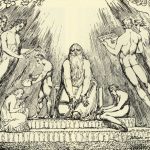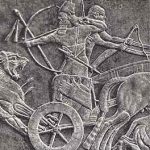Introduction
Paul’s use of the Old Testament (OT) in Colossians 1 is quite interesting. Throughout his entire letter, Paul does not once directly quote the OT yet he does frequently interact with it, especially in chapter 1. This has led to very little investigation by scholars into the use of the OT in Colossians, with only Gregory Beale and Christopher Beetham spending the time to properly investigate the issue to date. It is my proposal that Paul’s usage centers around the motif of creation and temple found throughout the Hebrew Bible and that he does this in a unique manner to explain the significance of the risen savior and how Yeshua’s resurrection holds the key to our new vocation as part of the new creation. In order to accomplish this, we will begin by identifying allusions and echoes of the OT in Colossians 1, then investigate the OT motif of creation and temple, and finally show how this motif provides the common ground which ties together Paul’s allusions and echoes in Colossians 1.
Use of the OT in Colossians 1
We will begin by investigating the detectable allusions and echoes to the OT found in Colossians 1 to determine their most likely origin(s). It is important to accurately identify echoes and so we will interact with Hays’ seven tests for detecting echoes: 1) Availability, 2) Volume (explicit repetition of words), 3) Recurrence of the passage, 4) Thematic coherence with the argument, 5) Historical plausibility, 6) History of interpretation, and 7) Satisfaction (does the proposed reading make sense?).[1] Beetham adds to this that, unlike an allusion, echoes may either be consciously or unconsciously added by the author, that they should have a single, identifiable source although the author is not necessarily intending to point the audience to that source, and thus, that echo is not dependent upon that source. This does not mean that we should not investigate the source, as he points out that investigation of the source deeply enhances and colors our understanding of the new context.[2] I would add that, since there are many times that Scripture echoes itself in the OT, while is one single, identifiable point of origin for an echo, this does not exclude other echoes of the original source in the OT from helping us develop a fully mature understanding of what message Paul and others intended to convey in these echoes.
Colossians 1:6,10
The first echo we find in Colossians 1 is in verse 6 and repeated again in verse 10, bearing fruit (καρποφορέω) and increasing (αὐξάνω). These two terms are first found together in Genesis 1:28 in God’s creational mandate to humanity, “bear fruit, multiply, fill the earth, and subdue it.” The Septuagint (LXX) renders the Hebrew imperative פְּר֥וּ (“bear fruit”) with the Greek imperative αὐξάνεσθε (“increase”) while Paul appears to translate this more literally as καρποφορούμενον in Col 1:6 and 1:10.[3] Instead, Paul uses αὐξάνω to translate the Hebrew רבה instead of the LXX’s πληθύνω. These differences, however, are not a barrier to identifying these two verses as echoing Genesis 1:28 since they are in fact a better rendering of the Hebrew text which Paul would have been fully aware of. This is further evidenced by Paul’s emphasis that this bearing fruit and increasing is occurring “in all the world”. Here, Paul uses κόσμος for ‘world’ while the LXX never translates אֶ֫רֶץ as κόσμος but rather uses γῆ but this is not problematic since by the time of the NT κόσμος was sometimes used synonymously with γῆ to indicate the created world.[4] This mandate for mankind to reflect God’s image into the world through bearing fruit and multiplying is not isolated to Genesis 1:28 either, it is repeated after the flood in Gen 9:1, in the covenant promises to the Patriarchs (Gen 12:2, 17:2, 22:17-18, 26:3, 28:3-4), in Egypt (Exod 1:7), in Leviticus’ demand for holiness (Lev 26:9), and many many other places throughout the Hebrew Bible. It is also probably alluded to in Yeshua’s parables of the fig tree and the wicked vinedressers and is also alluded to throughout Acts as the ekklesia increases in size. Thus, this reference easily meets our criteria for an echo.
Colossians 1:9-10
Colossians 1:9-10 reads, “that you will be filled (πληρόω) with the knowledge (ἐπίγνωσις) of His will in all wisdom (σοφία) and spiritual understanding (συνέσει πνευματικῇ) so that you will walk…in every good work (ἔργῳ ἀγαθῷ).” Beale identifies two possible allusions, Exodus 31:3 and Isaiah 11:2, and considers Exodus to be the most likely allusion since it also views the result of the filling (ἐμπίπλημι) is to accomplish God’s will in every good work (ἐν παντὶ ἔργῳ).[5] Exodus 31:3 also better matches the context of Colossians 1:9-10 in that it is human beings who are filled with this spirit rather than a messianic king. We will also discuss later how this also fits into the temple theme found within this chapter. This does not exclude awareness of Isaiah 11:2 since echoes are not necessarily conscious connections to a specific verse but could be representative of a mature theology developed from understanding underlying themes in Scripture. While there is more literary evidence connecting Colossians 1:9-10 with Exodus 31:3, the same Spirit of God that filled Bezalel in the Exodus is the same Spirit of YHWH that will rest upon the Messianic Branch of Isaiah. The believers in Colossae partake in Isaiah’s Spirit of YHWH through their union with Yeshua the Messiah.[6]
Colossians 1:12-14
Colossians 1:12-14 does not meet our requirements for an echo since it is not echoing any specific text, but the imagery that Paul uses is rooted in the language of the Exodus and the subsequent inheritance of the promised land,[7] thus we will include it in our analysis. Paul’s use of the terms saints (ἅγιος),[8] inheritance (κλῆρος),[9] rescue from (ῥύομαι + ἐκ)[10] the authority of darkness, kingdom (βασιλεία),[11] and redemption (ἀπολύτρωσις)[12] all bring very strong imagery of the Exodus story. Beetham points out that none of these words point to the Exodus on their own, but when taken together, their effect is cumulative and is easily recognizable.[13]
The Exodus was also echoed later in the OT in the prophesied second/greater exodus in Jeremiah, Isaiah, Ezekiel, Psalms, and others. Psalm 107:2-14 speaks of bringing the redeemed (λελυτρωμένοι) of YHWH from all the lands, bringing them out (ἐξάγω)[14] of darkness. The concept of being brought out of darkness may have developed from the contrast between light and darkness in the original exodus narrative (Exod. 10:21-23, 14:20).[15] This new exodus motif that has been recognized by scholars for a long time is especially concentrated in Isaiah chapters 40-55[16] where it is often paralleled with creation language. As we will discuss below, the original exodus as well as subsequent exodus motifs are all understood in the light of creation and new creation. Interestingly, while the original exodus is never understood in the context of the forgiveness of sins, this does become a major emphasis for the second exodus since it was understood that the reason for the Babylonian exile was in fact due to the sins of the nation (Isa 40:2). Thus the phrase “forgiveness of sins” became synonymous with “redemption” and the concept of the greater exodus, the hope of national restoration.[17] While this may have originally understood as being fulfilled in the return program of King Cyrus from Babylon, Jewish exegetes of the 2nd Temple period living under Roman occupation had begun to reread these promises of a second exodus in a new light, anticipating a still future and greater event.[18] Thus we should understand Paul’s usage of this motif in Colossians 1:12-14 to be echoing both the original exodus narrative as well as the prophetic second/greater exodus showing that it is being fulfilled in an unexpected manner; deliverance from the realm of sin into the light of the kingdom of the beloved son, Yeshua.
Colossians 1:15-20
Colossians 1:15-20 is a poem constructed to explain the nature of “His beloved son, in whom we have redemption; the forgiveness of sins (1:13b-14). Some modern readers have had a tendency to view this passage as Paul’s attempt to explain the pre-existence of Yeshua prior to his first-century advent, and Paul probably believed this (cf. Philippians 2:5-11), but it fails to understand the true depth of Paul’s message which only comes to light when we understand the echoes from the OT. Paul’s usage of the present tense “is” (ἐστιν) indicates that, while Yeshua was the image of God before creation, it is more important that he still is that “image”.[19] This poem echoes the Wisdom motif of Proverbs 8:22-31 that had been developed by the first century C.E. in Jewish literature as well as echoing the creation motif found not only in Genesis 1, but also in Isaiah and the Psalms that we will discuss in detail in a later section.
The poem refers to Yeshua as the “firstborn of creation” and the “image of the invisible God”. Both allude back to the first man that God created in Genesis 1:27, “God created the Adam in His own image, in the image of God He created him.” This may not seem significant until we recognize that after being expelled from the garden, Adam reproduces after his own image. Genesis 5:1-3 set up a contrast between Adam who is in the image (εἰκών) of God and is blessed and Seth who is not in the image of God, but is in the image of (fallen) Adam. Paul refers to this concept elsewhere in his letters where he contrasts the first Adam as the image of the earthy and the last Adam as having the image of heaven (1 Cor. 15:45-19) and explains how death entered through the sin of one man (Rom. 5:12-14, cf. 1 Cor. 15:21-22). The allusion implies that Messiah is the pristine image of what the first Adam should have been.[20] Paul also puts forth in Colossians 3:9-10 that believers are supposed to have put on a newness that restores them back to being in the image of God.
While the OT nowhere refers to Adam as being firstborn, as the first man created it is not a stretch to see the connection that Paul makes, especially in light of the image allusion. The OT clearly asserts the preeminence of the firstborn status in each Israelite family as early as the struggles between Jacob and Esau, but also indicates through narrative that man’s “firstborn” may in fact not be the one whom God chooses to receive that authority.[21] Yet in most cases, it is in fact the literal firstborn who receives inheritance rights and thus authority. This concept becomes extremely important during the Exodus narrative when God slays the firstborn of Egypt and subsequently requires Israel to dedicate the firstborn of both man and beast to YHWH through sacrifice or redemption because He spared their firstborn in Egypt (Exod. 13:15). Israel is also called God’s “firstborn” (Exod. 4:22-23) most likely because they were given the same mandate as Adam and Noah, to be fruitful and multiply (Gen 1:28, 9:1; cf. Lev 26:9). Israel was a corporate Adamic figure sent to accomplish the original mission, but like Adam, they failed and so Paul is using this imagery to show that Messiah is the one who completes this mission.[22] Finally, we should also note that Psalm 89, which twice contains the word מָשִׁיחַ/χριστός, says of this Messianic figure, “I will also make him My firstborn, the highest of the kings of the earth” (89:27).
NT Wright makes an interesting observation that in Col 1:15-18, Paul is playing on various meanings of the Hebrew word ראשׁית, which is the first word in the Bible.[23] ראשׁית means “what comes first, beginning, starting point, the first and best”[24] and is from the root רֹאשׁ which means “head of a person, leader, chief.”[25] Thus there are four detectable meanings of ראשׁית/רֹאשׁ in our passage: 1) He is the firstborn[26] (1:15, 18), 2) He is before all things (1:17), 3) He is the head of the body (1:18), and 4) He is the beginning (1:18). The full weight of this is brought to bear on the final word in the series, ἀρχή, which is translated by the LXX for the Hebrew ראשׁית in both Genesis 1:1 and Proverbs 8:22. Thus, Paul is using this play on the word to emphasize the positional authority of Yeshua over everything.
The final echo in Colossians 1:15-20 is that of “Wisdom” in Jewish thought, especially found in Proverbs 8:22-27. In Proverbs 8:22LXX, personified “Wisdom” says, “YHWH created (κτίζω) me at the beginning (ἀρχή) of His way, before His works of old.” In later rabbinical literature, personified Wisdom is consistently identified as the Torah,[27] most likely based on Deuteronomy 4:6 which states that the statutes and judgments set forth in the Torah will be your wisdom (σοφία) and understanding. It is most likely then that during Paul’s lifetime, at least some Jewish groups would have had a similar understanding of Torah as Wisdom as well. Yeshua did not come to abolish the Torah (or the Prophets), he came to fulfill (Matt 5:17), that is to give full, proper, and complete meaning to the Wisdom that was started with the Torah. Thus, Paul’s usage of Wisdom motif exemplifies that Messiah is the greatest expression of divine wisdom on earth, the Torah pointing to this reality.[28]
Colossians 1:19
Our final echo in Colossians 1 is found in verse 19, “for it was the Father’s good pleasure (εὐδοκέω) all the fullness [of the Father] to dwell (κατοικέω) in [Yeshua].”[29] Unfortunately, there has been too much focus on only “fullness” (πλήρωμα) without addressing these other key words which actually reveal Yeshua as fulfilling the role assigned to the Temple.[30] Some commentators have noticed that there is an echo here of Psalm 68:16 (67:17LXX) in that they both share the words “good pleasure” (εὐδοκέω) and “dwell” (κατοικέω). The context of Psalm 68:16 is the Temple, and throughout the Hebrew Bible the dwelling place of the presence of God is indeed the Tabernacle or Temple. Thus, by understanding that this is indeed an echo, we see that Paul is expressing a similar message that is found elsewhere in the NT (cf. John 2:19-21; Rev. 21:22); Yeshua is the Temple in that the presence of God dwells within him and that he becomes the locus of where God’s presence is mediated to the people.[31]
Creation Theme in the OT
By analyzing Paul’s usage of OT echoes and allusions, the themes of the creation mandate (Gen. 1:28), Tabernacle/Temple building, filling with the Spirit of God, the original Exodus and the second/greater Exodus, Yeshua as the undefiled image of God, Yeshua as the firstborn of new creation (restored humanity), Yeshua as the true Wisdom of God, and Yeshua as the Temple with the indwelling presence of God. While these may appear as unrelated subjects, they are all under the umbrella of the motif of new creation that runs throughout the Bible.
It is important to first properly understand what “creation” meant in the ancient world. While we may typically think of creation in terms of the origins of the material world, this is not how ancient man conceptualized it. For ancient man, creation was not primarily the origin of the world, it was concerned with the present world and the natural environment of humanity. Order was established through creation and renewed often annually and was primarily concerned with political order rather than natural order (although they were considered two sides of the same coin). This order came about through battle against chaos where the enemies are repulsed and destroyed. Thus, cosmic, political, and social order found their unity under the motif of “creation”.[32] An important aspect of the order of creation was kingship ideology of the ancient Near East. The king was understood as either the incarnation of or son of the chief deity (i.e. the representative on earth) and thus the king functioned as the earthly guarantor of the order of creation.[33] Whenever damage was inflicted upon the creation order, it was imperative that such damage be repaired and the key Hebrew term for this repair is šillēm, “to make intact,” “to restore šālôm.”[34] Paul’s use of “new creation” motif in regards to the community of believers (Eph. 2:15, 4:23-24; Col. 3:9) is used primarily to signify a unified community in Messiah with no regards to ethnicity or other cultural barriers.[35] This understanding helps us understand Paul’s statement of Yeshua “having made peace (εἰρηνοποιέω) through the blood of His cross” (Col 1:20), that is, he restored the order of creation where we are just renewed humanity, and not divided into many different ethnic groups. This influx of Gentiles into the worshipping community of God was predicted in Isaiah 66:20-23 which sets this event in the context of the “new heavens and the new earth.” It should also be noted that this “new heavens” and “new earth” were never expected to be a replacement of the world of creation with another, nor was there an expectation of escape to another location. For OT and NT writers alike, new creation was understood as a transformation of creation into the world God had intended for humanity to rule.[36]
In the OT, creation vocabulary is most heavily concentrated in the latter half of Isaiah. These chapters speak of a new creation of YHWH’s people that will be God’s new act of redemption, the new Exodus that will result in the re-creation of His people.[37] The reason why redemption can be expressed in terms of creation is because God’s creative activity in the Bible includes the work of originating, continuing, and completing creation. God’s salvation is the restoration of the exiles to continue the work of creation.[38] Thus, the concepts of redemption, salvation, and exodus all fall under the motif of new creation in the OT. Apocalyptic Jewish writers of the 2nd Temple period (Jubilees, 1 Enoch, 2 Apocalypse of Baruch) developed this anticipated new creation further into concepts of the restoration of Israel, the transformation of the righteous in the resurrection of the dead, the liberation of the natural world, and the restoration of creation back to its original state (return to Eden).[39]
The final concept associated with the creation motif is the Tabernacle/Temple. It has been noted that the description of the Tabernacle has many similarities to the creation account in Genesis 1-3[40]. Adam’s duties of to “work” and “guard” the Garden are used multiple times later in the Torah to describe the duties of the priests. There were three levels of sacred in the Garden (Eden, the Garden, the land to the east) just as there were three levels of sacred in the Tabernacle. God’s presence dwelt and walked in the Garden just as it dwelt in the Tabernacle and walked within the camp (Lev 26:11-12). While we could discuss many of the other parallels, it is beyond the scope of this paper. There is, however, one final parallel that is perhaps the most significant; Adam and Eve were expelled eastward away from the Garden, away from God’s presence. The geographical orientation of the Tabernacle places the only entrance to the tent on the east side, thus the only way to enter is to come from the east going westward. Thus, it is a reversal of the pattern of expulsion, a return to Eden, a return to the creation order. Thus, the Tabernacle serves as a small location on earth where creation order exists, where heaven and earth meet, where the presence of God dwells and generates blessings for the community. And as a priestly kingdom, Israel was tasked with expanding this place of creation order by serving as a conduit of blessings to the nations.[41]
Colossians 1 use of Creation Motif
Paul’s letter to the Colossians makes use of the various elements of the new creation motif using OT echoes and allusions. He begins by commending the believers for living out the creation mandate of being fruitful and increasing (1:6, 10). He alludes to the building of the articles of the Tabernacle, which represents the return to Edenic creation (1:9). He echoes the exodus and second/greater exodus theme which were understood as a new creation of the nation (1:12-14). He is the true image of God, as Adam was in his original creation (1:15a). He is the firstborn of creation of social structures; thrones, dominions, rulers, and authorities (1:15b-16). He is the firstborn of the resurrection of the dead, the first one born into new creation (1:18). He is the Temple, the place where God’s presence finds pleasure in dwelling (1:19). And because of His ascent to new creation, we are called to put on the new creation and be restored to the image of God (3:9-10). These things fall into the concept of the restoration of the human vocation to be image-bearers of YHWH which is made possible through the death and resurrection of Yeshua.
Conclusion
Through careful analysis of the usage of OT allusions and echoes in Colossians 1, we have identified that Paul is interacting with the OT in a purposeful manner. Paul uses various sub themes of the new creation motif in order to paint a vivid picture that Yeshua is the image of God that Adam was created to be, he is the first to be raised from the dead into such a state and thus has authority over all those who are becoming like him. Paul uses this as the basis for emphasizing that the believers in Colossae are indeed being transformed into this image which bears fruit and encourages them to act accordingly. We have hopefully also shown that without an appreciation for echoes of the OT, the reader cannot truly grasp the full significance of Paul’s message. This does not mean that Paul was consciously echoing specific verses nor that his audience was understanding all of the references, such a claim can neither be proven nor disproven. However, anyone versed in Israel’s Scriptures as Paul and undoubtedly his audience were should have picked up on the thematic connections in the letter and understood the deeper meaning that Paul is attempting to convey.
References
Beale, G. K. “Colossians,” in Commentary on the New Testament Use of the Old Testament. Grand Rapids, MI: Baker Academic; Apollos, 2007.
Beale, “Garden Temple,” Kerux V18 N2 A1. Accessed at http://kerux.com/doc/1802A1.asp on 12/4/16.
Beale, G. K. The Temple and the Church’s Mission: A Biblical Theology of the Dwelling Place of God. Downers Grove, IL; England: InterVarsity Press; Apollos, 2004.
Beale, G.K. and Mitchell Kim. God Dwells Among Us: Expanding Eden to the Ends of the Earth. Downers Grove, IL: InterVarsity Press, 2014 (iBooks).
Beetham, Christopher. Echoes of Scripture in the Letter of Paul to the Colossians. Atlanta: Society of Biblical Literature, 2010.
Brown, William. The Ethos of the Cosmos. Grand Rapids, MI: William B. Eerdmans Publishing Company, 1999.
Fretheim, Terence. God and World in the Old Testament. Nashville: Abingdon Press, 2005. 32
Hawthorne, Gerald. Ralph Martin, and Daniel Reid, eds. Dictionary of Paul and His Letters. Downers Grove, IL: InterVarsity Press, 1993.
Hays, Richard. Echoes of Scripture in the Letters of Paul. New Haven & London: Yale University Press, 1989.
Hiebert, Theodore. “Creation,” ed. Katharine Doob Sakenfeld, The New Interpreter’s Dictionary of the Bible. Nashville, TN: Abingdon Press, 2006–2009.
Hubbard, Moyer. New Creation in Paul’s Letters and Thought. New York: Cambridge University Press, 2002.
Lee, Yongbom. “New Creation,” ed. John D. Barry et al., The Lexham Bible Dictionary. Bellingham, WA: Lexham Press, 2016 (LOGOS).
Ludwig Koehler et al., The Hebrew and Aramaic Lexicon of the Old Testament. Leiden: E.J. Brill, 1994–2000.
Schmid, H. “Creation, Righteousness, and Salvation,” ed. by Bernhard Anderson. Creation in the Old Testament. Philadelphia: Fortress Press, 1984.
Wright, N.T. The Climax of the Covenant. Minneapolis: Fortress Press, 1992.
Wright, N.T. The Day the Revolution Began. HarperCollins Publishers, 2016 (iBooks).
[1] Hays, Echoes of Scripture in the Letters of Paul, 29-31.
[2] Beetham, Echoes of Scripture in the Letter of Paul to the Colossians, 20-22.
[3] Beale, The Temple and the Church’s Mission, 264.
[4] Beale, “Colossians,” 842.
[5] ibid, 847.
[6] Beetham, Echoes of Scripture in the Letter of Paul to the Colossians, 78.
[7] Beale, “Colossians,” 848.
[8] cf. Exod. 22:31; Lev. 11:44-45, 19:2; Num. 15:40, 16:3.
[9] cf. Num. 26:55-56, 33:54; Deut. 4:21, 15:4, Jos. 14:2, 17:14, and many others.
[10] cf. Exod. 6:6; Jdg. 6:9.
[11] cf. Exod. 19:6.
[12] cf. Exod. 6:6, 15:3; Deut. 7:8, 9:26, and others.
[13] Beetham, Echoes of Scripture in the Letter of Paul to the Colossians, 82.
[14] ἐξάγω is the word from which we get the English word “exodus”.
[15] Beale, “Colossians,” 849.
[16] Beetham, Echoes of Scripture in the Letter of Paul to the Colossians, 86.
[17] Wright, The Day the Revolution Began, 138/553 (iBooks).
[18] Beetham, Echoes of Scripture in the Letter of Paul to the Colossians, 89.
[19] Beale, “Colossians,” 855.
[20] ibid, 852.
[21] This can be seen in the example of Jacob and Esau, Moses and Aaron, Saul and David, and other narratives where leadership is granted to a non-firstborn.
[22] Beale, “Colossians,” 853.
[23] Wright, The Climax of the Covenant, 111-112.
[24] Koehler et al., The Hebrew and Aramaic Lexicon of the Old Testament, 1169.
[25] ibid, 1167.
[26] While there is a different word for “firstborn” in Hebrew, it still falls within the semantic range of ראשׁית as being “what comes first.”
[27] Beetham, Echoes of Scripture in the Letter of Paul to the Colossians, 129.
[28] Beale, “Colossians,” 855.
[29] New American Standard Bible Translation.
[30] Beale, “Colossians,” 856.
[31] Beale and Kim, God Dwells Among Us, 119-120 of 362 (iBooks).
[32] Schmid, “Creation, Righteousness, and Salvation,” 103-104.
[33] ibid, 105.
[34] ibid.
[35] Lee, “New Creation,” The Lexham Bible Dictionary.
[36]Hiebert, “Creation,” 787.
[37] Hubbard, Paul’s Letters and Thought, 15.
[38] Fretheim, God and World in the Old Testament, 4-8.
[39] Hawthorne, et. al. Dictionary of Paul and His Letters, 189.
[40] See especially Beale, “Garden Temple,” Kerux V18 N2.
[41] Brown, The Ethos of the Cosmos, 131.








